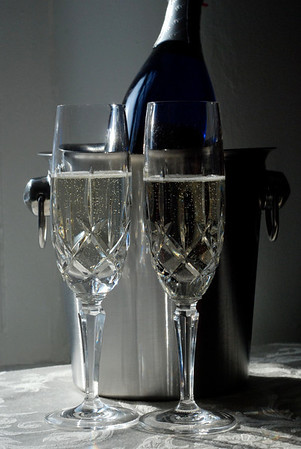It’s one of my favorite lines from the BBC series “Little Britain.” It’s also the phrase that I hear frequently during this holiday season. Champagne and New Year’s Eve go together like turkey and Thanksgiving, chocolate and Valentine’s Day, eggs and . . . well, you get the idea.

Although many countries produce sparkling wines, only the Champagne region of northeast France creates the bubbly beverage known as champagne. This region has been crafting its eponymous libation since the 17th century. Unsurprisingly, the area is home to some of the oldest champagne houses including Taittinger, Veuve Clicquot and Moet and Chandon.
Various legends surround the origins of the first champagne. Many point to the Benedictine monk and cellar master of the Abbey of Hautvillers, Dom Perignon, as its inventor. While Perignon did develop the techniques of blending wines to improve the flavor and of tying down corks with strings or wire cages to prevent popping or bottle breakage, he did not create champagne.
Apparently, no one invented champagne. The drink’s trademark fizziness was merely a side effect of the cold climate delaying fermentation. Carbon dioxide would build up in the bottles and turn the still wine into bubbly. Voila! Champagne for everyone! It may seem a bit simplistic and unromantic but that’s reportedly how champagne was born.
When it comes time to select a champagne, consider how you like your drinks. As I prefer dry wines, I go with the driest offering, a brut. This contains little to no sugar. However, if you prefer a slightly sweeter beverage, go with extra dry. If you want something moderately sweet, reach for the sec and demi-sec. These have higher sugar contents than brut or extra dry. Should you crave sweetness of a dessert wine, choose doux.
To serve champagne, simply chill, open and pour. If you want to whip up a cocktail, be sure to use a cheaper champagne as your base. Why waste all that flavor – and money – when the drink will be altered by other ingredients?
Although I know how to stir together a refreshment or two, I’m definitely not an authority on champagne cocktails. As a result, the following recipes appear courtesy of Stuart Walton’s The Ultimate Book of Cocktails (Hermes House, 2003). However, if you’re at all like me, you’ll skip the extra ingredients and just enjoy your champagne naturally.
MARILYN MONROE
Serves 1
6 tablespoons chilled champagne
1 1/2 tablespoon calvados
1 teaspoon grenadine
cocktail cherries, optional garnish
Pour the ingredients into a champagne glass and stir gently to combine. Garnish with optional cocktail cherries.
BLACKBERRY AND CHAMPAGNE CRUSH
Serves 2
6 ounces blackberries, washed
1 tablespoon confectioner’s sugar
8 ounces champagne/sparkling wine, chilled
2 tablespoons cognac
Puree the blackberries in a food processor. Push the puree through a sieve and then add the sugar and return the mixture to the food processor. Add the champagne/sparkling wine and pulse once.
Pour the cognac into two champagne glasses. Add the blackberry-champagne puree to the glasses and serve immediately.